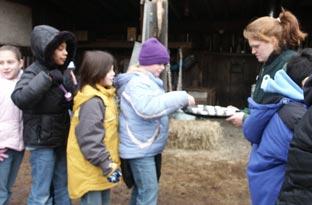Is It Syrup Yet?

Syrup Quality
The highest quality of syrup is a light amber color, free of cloudiness, and with a mild maple flavor. Color and cloudiness are judged on a nine-point scale. Fancy table syrup (Grade AA) can be held up to the light and a newspaper easily read through it. Objects look more and more cloudy through Grades A and B syrups, though these are still table grades.
Syrup that does not meet specifications for table use is reprocessed for commercial uses in curing tobacco and other such industries. “Buddy syrup”, or the end of the season runs when the buds are beginning to open, is used only for such purposes because of its strong, bitter flavor and dark cloudy color.
The composition of syrup typically includes:
- 98% sugars
- 0.5% miscellaneous
- 0.3% organic acids
- 0.8% ash
- 0.4% protein
For nutritional information on maple sap and syrup, visit the Massachusetts Maple Producers Association.
Vermont Maple Syrup Grades
Vermont Fancy
Vermont Fancy has a light amber color and a delicate maple bouquet. Fancy grade has a mild flavor and is excellent on ice cream, desserts or on food which permits its subtle flavor to be appreciated. This is the preferred grade for candies and other maple specialties.
Grade A Medium Amber
Grade A Medium Amber has a medium amber color and a distinct maple bouquet. It has the characteristic maple flavor and is the most popular for all-around use.
Grade A Dark Amber
Grade A Dark Amber has a dark amber color and a pronounced maple bouquet. It has a heartier maple flavor and is also popular for table and all-around use.
Vermont Grade B
Vermont Grade B is the darkest table grade syrup and has a robust maple bouquet. It is an excellent choice for cooking.
A gallon of water weighs about eight pounds while a gallon of syrup weighs about eleven pounds.
Maple sap and syrup are classified as a perishable food item. Because of the sugar content of the sap or syrup, deterioration of its quality may result from activity of yeasts, molds, and/or bacteria. One of the most recent innovations in sanitation and storage of sap has been the use of ultraviolet rays. The ultraviolet rays help prevent fermentation of the sap. Syrup must be packaged at a temperature of 190 degrees Fahrenheit or higher and then cooled slowly. The container is capped immediately. Once opened, the syrup should be refrigerated to prevent loss of freshness and sweetness through the growth of molds and/or bacteria.
All collection and storage equipment must be washed in boiling water and rinsed in 20% chlorine solution at the beginning and end of the sugaring season, and as often during the season as practical. Spiles and tubing need to be completely sanitized only once each season.
